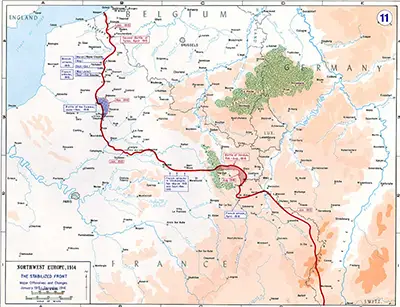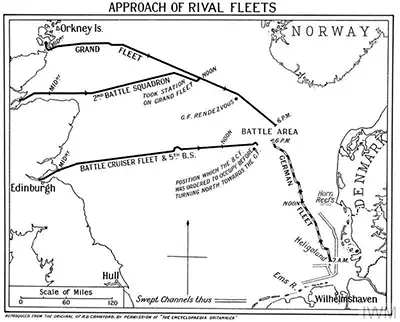World War I
Part 4: 1916 Germany in early 1916 had targeted the French stronghold of Verdun. Despite weather delays, the German attack commenced before the end of February. Wave after wave of soldiers traded fire on both sides, for many months. The Battle of Verdun was, in fact, the longest battle of the war. German forces initially captured a number of other French strongholds. By July, the Allied armies had begun an attack further north, on the River Somme. 
When the German Army attacked Verdun, the French government implored its allies to attack Germany elsewhere, to pull German troops away. Russian commanders promised to attack in the east and did so, commencing at Lake Narocz in March. The result there was the same as at Tannenberg–convincing German victory. Russian commanders planned their next attack in north, near Vilna, which is now in Poland. At the same time, General Alexei Brusilov convinced the Russian high command to approve his plan to attack in the southwest, targeting Austria-Hungary. The Brusilov Offensive began on June 4. The strategy was to attack along a long line, preventing the enemy from reinforcing against any breakthroughs in the line. The strategy was overwhelmingly successful, partly because the commander had eschewed the familiar pattern of a dayslong bombardment followed by a massive, slow-moving attack, instead keeping the bombardment short and targeted and then launching a massive attack along a very long and wide line. The Russians quickly took Lutsk, narrowly missing an escaping Austrian commander Archduke Josef Ferdinand. In just two days, the Russian army advanced nearly 50 miles through a collapsing Austro-Hungarian defense. The German strategy had been to make the Allies fight a war of attrition, and the Battle of the Somme achieved that. German success at Verdun turned into failure, eventually. That, coupled with a slow but steady advance by the Allied forces at the Somme convinced the German high command in late August to remove the overall leader, Erich von Falkenhayn, and replace him with Paul von Hindenburg, famous for his part in the Eastern Front victory at Tannenberg in 1914. The result was a shift in focus, with German lines falling back but only in order to achieve a position of superior defense, while at the same time refocusing on the war in the east, in response to a major Russian victory over Austria-Hungary in what is now Ukraine. The result by year's end was a huge increase in the number of casualties, on both sides, without a corresponding change in territory held. Maritime conflicts: 1916

In the spring of 1916, the German Admiral Reinhard Scheer decided on a plan of bait-and-switch, whereby a number of German ships would steam out into the North Sea and lure the battlecruisers of the British Grand Fleet into a pitched battle that would then become an ambush, as the rest of the High Seas Fleet descended on only one part of the Grand Fleet. To that end, Admiral Franz Hipper led a group of German battlecruisers in an attack on merchant shipping in the Skagerrak, the waters between Denmark and Norway. They set out on May 31. The fleets clashed the following day, in the Battle of Jutland. Those who had hoped to lay a trap instead sailed into one. In desperation, Scheer ordered his fleet to head southwest, away from the British guns, making smoke to conceal their direction. At 7 p.m., however, the German ships turned again and headed back toward the enemy, at one point exposing their starboard sides to the entirety of the U.K. guns. This enabled the Grand Fleet to "cross the German T," performing an ideal naval maneuver that allowed one side maximum advantage while denying the other side the same opportunity. Both sides claimed victory. German forces quoted enemy casualty figures exceeding 6,500 killed and wounded, whereas German casualties numbered just more than 3,000; as well, the German fleet lost fewer ships, sinking three more than did their enemy. The practical effect, however, was that it was the last major naval clash between German and U.K. forces during the war and that the German fleet did not gain control of the North Sea or the Atlantic Ocean. Near the end of 1916, the German government issued a peace proposal. The Allied powers refused the peace proposal, mainly because they had decided that the only way to end the war was to defeat Germany. The peace proposal called for a return to prewar boundaries but said nothing about damage already done. In response, the German high command decided to pull back behind a well constructed line of defense, in order to consolidate the position in the west so the focus could shift to the east, with the hope of ousting Russia for good. During the latter months of 1916 and into the following year, German armies completed the Hindenburg Line, a 50-mile-long system of fortified and entrenched positions. German forces trooped behind the line under the cover of winter, when neither side had appetite for an offensive. As well, some German forces engaged in a ruse, convincing more than one Allied commander that an attack was imminent. The Alberich Maneuver, as it came to be known, took 35 days to complete. By mid-April 1917, the Hindenburg Line was finished and its defenders behind it. Aerial conflicts: 1916
|
|
Social Studies for Kids
copyright 2002–2024
David White




